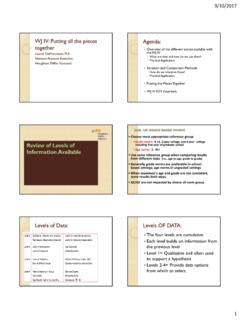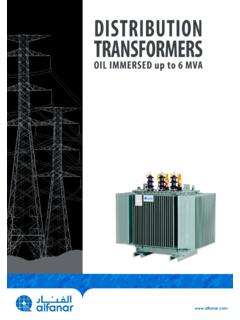Transcription of 8. TESTING POWER TRANSFORMERS
1 8. TESTING POWER TRANSFORMERS High-voltage TRANSFORMERS are some of the most important (and expensive) pieces of equipment required for operating a POWER system. The purchase, preparation, assembly, operation and maintenance of TRANSFORMERS represent a large expense to the POWER system. OVERVIEW When TRANSFORMERS are received from the factory or reallocated from another location it is necessary to verify that each transformer is dry, no damage has occurred during shipping, internal connections have not been loosened, the transformer s ratio, polarity, and impedance agree with its nameplate, its major insulation structure is intact, wiring insulation has not been bridged, and the transformer is ready for service. Physical size, voltage class, and kVA rating are the major factors that dictate the amount of preparation required to put TRANSFORMERS in service. Size and kVA rating also dictate the kind and number of auxiliary devices a transformer will require.
2 All of these factors affect the amount of TESTING necessary to certify that a transformer is ready to be energized and placed in service. There are a multitude of checks and tests performed as a transformer is being assembled at a substation. The test engineer may not directly perform all of the following tests and inspections but must be sure they are satisfactorily completed, so that the final decision over transformer bank readiness for energization can be made. Some tests and procedures may be performed by specialists during the assembly phase. Special tests, other than those listed, may also be required. Many require special equipment and expertise that construction electricians do not have and are not expected to provide. Some tests are performed by an assembly crew, while other tests are done by the person(s) making the final electrical tests on the TRANSFORMERS . BPA has hundreds of POWER TRANSFORMERS installed throughout the system, and few of them are identical.
3 The following information is not intended to describe, or include, the details for performing the entire array of tests needed to prepare TRANSFORMERS for service, only the tests that may be performed by field personnel. Even though details have been limited, descriptions should allow field personnel to perform, or assist in performing, the basic tests they may be asked to do. Procedures and tests are described somewhat generically, but apply to most TRANSFORMERS in one way or another. Also, the following test descriptions provide an anchor point from which to ask for help when needed. The following items are discussed or described: Nameplate Data POWER Meggering Auxiliary Components and Wire Checks Lightning Arrestors Hand Meggering Temperature Devices CT Tests Winding Temperature and Thermal Image Bushing POWER Factoring Remote Temperature Indication Transformer POWER Factoring Auxiliary POWER Voltage Ratio Automatic Transfer Switch Polarity Cooling System Transformer-Turns Ratio Bushing Potential Device Tap Changers Auxiliary-Equipment Protection and Alarms Short-Circuit Impedance Overall Loading Zero Sequence Trip Checks Winding Resistance Before proceding with transformer measurements the test engineer will become familiar with the safety rules of Section 2.
4 THESE RULES MUST BE FOLLOWED FOR ALL TEST PROCEDURES. Following is an approximate sequence for transformer TESTING : 1. Inspect transformer and parts for shipping damage and moisture. 2. Check nameplate and prints for proper voltages and external phasing connection to the line or bus. 3. Check calibration of all thermal gauges and hot-spot heater, bridge RTDs and associated alarm contacts. Contact settings should be similar to the following: One stage runs all the time (forced cooling) 2nd stage at 80 C 3rd stage at 90 C Hot-spot alarm 100 C (trip at 110 C when applicable) Top-oil alarm 80 C at 55 C rise and 75 C at 65 C rise OA = no fans or pumps FA =fans running FOA = fans and pumps running 4. Check and Megger all wiring point to point: Fans, pumps, alarms, heaters, tap changers, and all other devices on the transformer and interconnecting cables 5. All banks above 150 MVA should be vacuum dried.
5 Do not apply test voltages to the winding during the vacuum drying process. Make certain the terminals are shorted and grounded during oil circulation because of the large amount of static charge that can build up on the winding. 6. After the tank has been filled with oil, confirm that an oil sample was sent to the Chemical Lab and that its results are entered in the bank test reports. Note the oil level and temperature at completion of filling. 7. POWER operate to verify proper rotation of pumps and fans and correct operation of the under load (UL) tap changer, when provided. Also, check heater, alarms and all other devices for proper operation. 12. Following are the winding tests to be performed: Ratio and Polarity (Voltage Method or TTR). The preference is that all large POWER TRANSFORMERS (>1 MVA) be tested with TTR test set. Impedance DC winding resistance Megger and POWER Factor windings, bushing and arrestors.
6 Note: Wait until 24 hours after completion of oil filling for POWER Factor TESTING . 13. Load CT circuits overall and flash for polarity. 14. Before energization, trip-check bank protection schemes and make sure the gas-collection relay is free of gas. 15. When energizing a bank or picking up load, monitor bank currents and voltages, including UL tap-changer operation. 16. Check proper phasing and voltage of the bank to the system before load is picked up. When possible, large TRANSFORMERS (>1 MVA) should remain energized for eight hours before carrying load. 17. Make in-service checks on meters and relays. 18. Release to Operations and report energization information to the TNE office. 19. Turn in revised prints and test reports, which should include the following: All test data Moisture and oil data Problems incurred In-service data Time energized and release to operation Any unusual problem that information will aid in future equipment TESTING NAMEPLATE DATA and TERMINAL MARKINGS Collecting nameplate data is not TESTING , but it must be done for all equipment.
7 This data is recorded by the person(s) performing the equipment tests. The act of recording the nameplate data also helps test personnel familiarize themselves with the unit to be tested. For a transformer, much of the needed information can be obtained from the main nameplate. If there is an under load tap changer, it too will have a nameplate. CTs have name plates and may have them on the bushing pockets where they are mounted with additional information on a nameplate placed inside the cooler-control cabinet door (typical on large TRANSFORMERS ). Bushings, fuses, fan and pump motors, lightning arrestors, and disconnect switches will also have individual nameplates. An attempt should be made to fill in all pertinent spaces on the data sheet. A miscellaneous information space is provided on data sheets for information that pertains to the transformer but does not have a specified place to record it. Recording miscellaneous information not identified specifically by a test data sheet may be important as well.
8 Terminal marking of POWER TRANSFORMERS is determined by ANSI standards. Two-winding TRANSFORMERS have terminals designated by H and X ( H1, H2, X1, X2,), where H is the higher voltage-rated winding and X is the lower voltage winding. As viewed from the high-voltage side, H1 bushing terminal will be located on the right. Three-or-more-winding TRANSFORMERS will have winding designation H, X, Y and Z, where H is the high-voltage winding (or, the highest kVA-rated winding in case windings have the same voltage rating) and X, Y, and Z are for decreasing winding voltage ratings. AUXILIARY COMPONENTS AND WIRE CHECKING The size, type, and location of a transformer dictate the amount of external equipment associated with it. A transformer may be outfitted with devices that are not to be used at the time of installation. Even if not expected to be placed in service, all auxiliary equipment should be checked for proper operation to assure it is not defective and could be utilized in the future if needed.
9 This is especially true for a new transformer, in order to verify that what has been received is fully functional. All wiring on the transformer should be checked and verified prior to energization. Check control panels, terminal cabinets, and cables routed to the transformer. Torque all screw, nut, and bolt terminals for tightness, including the wires on CTs where they originate at the connection boxes on the high-voltage bushings. If there is an UL tap changer, its wiring must also be checked. Wire checking a transformer s auxiliary equipment is useful for several reasons. A thorough check might prevent damage or destruction of a unit that is difficult, expensive, or impossible to replace. This process also provides personnel an opportunity to become familiar with the equipment. A thorough wiring check forces personnel to look at the equipment in detail, serves as a cross check for drawings, and verifies that documentation and prints actually represent the physical equipment.
10 It helps assure that wires and components are properly sized, secure, and ready for service. HAND MEGGERING (DC Hi-Potential Insulation TESTING ) Most hand-crank Meggers have output voltages from 250 to 500 volts DC. All wiring on TRANSFORMERS should be Meggered at 250 or 500 VDC. Meggering transformer wiring is emphasized because of the numerous small terminal boxes mounted on large POWER TRANSFORMERS . Conduit connecting them together can have moisture accumulation or water leaks. In addition, when wiring is pulled through the metal conduit on a transformer, occasionally the insulation is scraped down to the bare wire. Also note that any box mounted on a vertical surface should have a small drain hole drilled at the bottom in case water leaks in from a loose conduit joint. Larger boxes or cabinets usually have resistive heaters and air-vent holes covered by screens to prevent moisture accumulation. Terminal boxes mounted on horizontal surfaces must have good weather seals for their covers.













